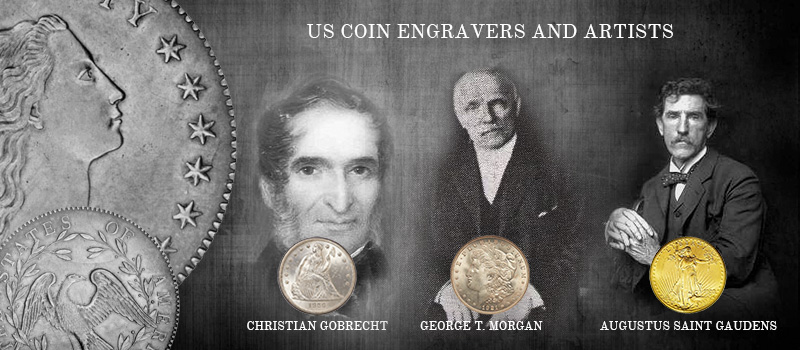US coin engravers and artists - Part 1

We have always talked about coins. Its our passion. But what about the artists behind the coins? The Coin engravers and artistsare the people who have managed to bring out the numismatist in you and me. They are the ones who have painstakingly brought out a thought or an entire story within a 1 inch coin. We have tried to piece together a post talking about these coin engravers, sculptors and artists who have made the US coins what it is today. As the post becamea bit longer than we thought it would, we would be puttingit up as a series. The first one is here.
Robert Scot
Joseph Wright was to hold the post of the 1st Chief Engraver of the new country. But because of an untimely death, Robert Scot took up the position. Scot migrated to America for a better life and landed in Virginia. After a stint in engraving currency, he moved to Philadelphia in 1781. He did as is believed the engravings for the Great Seal of United States in the Declaration of Independence and some book illustrations. His work was, it is said, seen and appreciated by Thomas Jefferson, the then future 3rd President of the USA. In 1793, he was commissioned for the office of the Chief Engraver of United States.[1]
His Flowing hair dollar was the first dollar coin released by the US mint in 1794. The obverse had the first-ever representation of Liberty, right-facing with flowing hair and 15 stars in the rim representing the states that had ratified the union till then. The reverse had a small eagle surrounded by a wreath.
Due to a growing dissatisfaction with the Flowing hair dollar, Scot then designed the Draped Bust Liberty for all denominations. The obverse had a buxom Liberty based on a portrait by Gilbert Stuart, with her hair tied with a ribbon.In the rim were the word LIBERTY and 13 stars symbolizing the first 13 states of the Union. The reverse was initially the value of the coin surrounded by a wreath, later it changed to a small eagle and then finally to the heraldic eagle. Scot laid the cornerstone for most US coin designs. His designs for different federal seals and the Great seal are retained to this day.
Christian Gobrecht
Christian Gobrecht was the third Chief Engraver of the United States mint. He was born in Pennysylvania and started his career in an ornamental clock shop. He then moved to Philadelphia and became an engraver for a private firm. In 1835, Gobrecht became a Second Engraver to William Kneass (the Second Chief Engraver) and most of the pattern and die-work was done by him after that.[2]
Gobrechts Seated Liberty design for the 'Gobrecht dollar' and the 'Seated Liberty dollar' later is the most famous of his designs. Thedesign depicted a Liberty seated on a boulder with a shield by the side and a staff with a pileus at the end. The Gobrecht dollar was released from 1836 to 1839 and had a reverse of a Soaring bald eagle with stars in one version and no stars in the other. The Seated Liberty dollars reverse was a bit different. It had an eagle with a shield on its chest. This wasscathingly referred to as a sandwich-board eagle by numismatic historian David Lange.
George T Morgan
The next great Chief Engraver was George T Morgan who had to play second fiddle for much of his career to the Barbers. Both William Barber and Charles Barber refused to acknowledge his position or his designs. George T Morgan, an Englishman by birth was recommended tothe then Mint Director Linderman, by Charles Fremantle of the Royal Mint in UK. When a re-design of the dollar was initiated the director was more favorable of Morgan's design than of Barber's.[3]
Though George T Morgan designed other coins, he would be known through history for the dollar coin named after him, the Morgan dollar. (More about how to collect Morgan dollars, here) The Morgan dollar's obverse design has the Lady Liberty wearing a Phrygian cap surrounded by 13 stars and the line E PLURIBUS UNUM. Thereverse design, has abald eagle clasping arrows and an olive branch.
Augustus Saint-Gaudens
In the list of great sculptors who were engaged independently by the mint for designing coins, the foremost was Augustus Saint-Gaudens. Saint-Gaudens was born in Ireland, but brought up in New York City. He traveled to Paris and studied in cole des Beaux-Arts. After that he went to Rome to study art and architecture. Saint-Gaudens, when he came back from Europe attracted commissions for sculptures that still stand to this day. In the turn of the 20th century, President Roosevelt lamented the absence of real artistic value in US coins. He chose Saint-Gaudens to design the gold eagles and breathe new life to US coins.[4]
Saint-Gaudens designed the double-eagle $20 and it is considered one of the most beautiful coins of all times. He also designed the Indian Head Eagle $10. (More about the Classic Gold coinshere) Saint-Gaudens also inspired and taught other sculptors like Adolph Weinman who designed the Walking Liberty Half Dollar.
REFERENCES
1.https://en.wikipedia.org/wiki/Robert_Scot
2.https://en.wikipedia.org/wiki/Christian_Gobrecht
3.https://en.wikipedia.org/wiki/George_T._Morgan
4.https://en.wikipedia.org/wiki/Augustus_Saint-Gaudens
This entry was posted in General on November 30, 2016 by lavanya kannan

Leave a comment